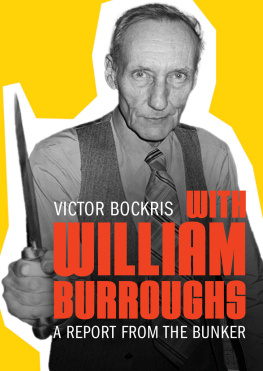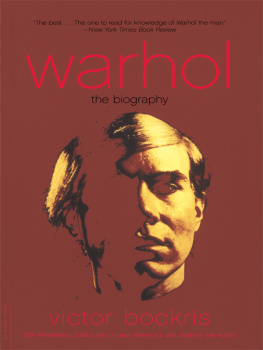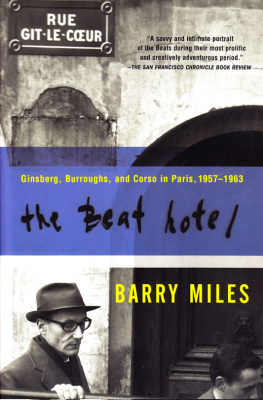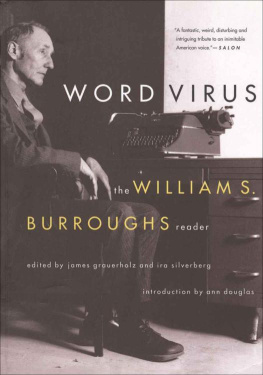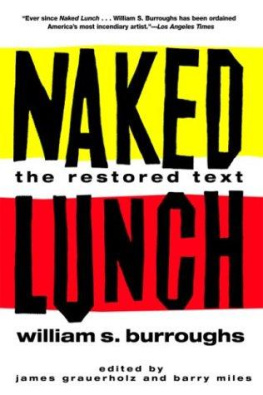
EARLY BIRD BOOKS
FRESH EBOOK DEALS, DELIVERED DAILY
LOVE TO READ ?
LOVE GREAT SALES ?
GET FANTASTIC DEALS ON BESTSELLING EBOOKS
DELIVERED TO YOUR INBOX EVERY DAY!

With William Burroughs
A Report from the Bunker
Victor Bockris

CONTENTS
INTRODUCTION TO THE REVISED EDITION
by Victor Bockris
Some things should be made clear about With William Burroughs: A Report from the Bunker, which focuses on Burroughss life in New York from 1974 to 1980.
Burroughs returned to New York City from London in 1974 after twenty-five years of self-imposed exile from the United States. Like all the significant geographical moves he has made during his careerfrom Mexico to Tangier in 1953, from Tangier to Paris in 1958, from Paris to London in 1962it signaled a new departure in his work as much as it signaled a new period in the cultures in which he is a powerful force.
In 1974 the New York punk rock movement was struggling to its feet. In fact, the first person who told me that Burroughs was back in town was Patti Smith. She announced his arrival from the stage of the St. Marks Poetry Project as if it were a move of military significance. Mr. Burroughs is back in town, she whooped. Isnt that great! Patti understood more than most his full significance. Not only did Burroughs dream the prophetic vision of the sixties as a love generation, he provided the punk rock movement, wittingly or unwittingly, with its basic credo: Nothing is true, everything is permitted. So far as I know, he is the only writer who sent a letter of support to The Sex Pistols when they released God Save the Queen. His own piece, Bugger the Queen, had been written three years earlier. There was a profound connection between the punks and William Burroughs: They were his children.
Williams arrival on the downtown scene came into prominence in 1978, when a three-day international conference, the Nova Convention, organized around the principle of celebrating Burroughss influence, took place in New York.
My book and my role in Burroughss life started in 1974 with conversations that took place during the course of several dinners at his place on the Bowery, referred to by Bill as the Bunker, and my apartment at 106 Perry Street in the West Village. They were taped for a profile in People magazine that was never published. One of our first dinners included Bill Wyman of the Rolling Stones, who showed up three hours late, making a bad impression on a man whose impeccable etiquette was leftover from a different era. But it was not until 1978 that I was able to really get involved with Burroughs. I first worked for him as an aide during the Nova Convention and progressed from being an interviewer to a colleague. Gradually, I became a part of his inner circle, that with tongue firmly in cheek may be called the Bunker Mafia.
The Bunker was a large three-room space that had originally been the locker room of a gymnasium on the second floor of 222 Bowery in the heart of the Lower East Side. The windowless, totally white, starkly lit cavern of a space was three blocks south of CBGB and across the street from a block-long heroin supermarket, where among other blends was one called Dr. Nova in honor of Burroughss 1964 novel Nova Express. To get into the Bunker one had to pass through three locked gates and a gray bulletproof metal door. To get through the gates you had to telephone from a nearby phone booth, at which point someone would come down and laboriously unlock, then relock three gates before leading you up the single flight of gray stone stairs to the ominous front door of William S. Burroughss headquarters. Often, the phone would be engaged and you would find yourself on a dark, cold, wet night freezing your ass off while desperately trying to get through, furtively glancing around for potential muggers.
It was, however, always more than worth the wait, numb though you might become, for upon admittance you entered a world as hermetic, individual, and electricas full of love and tensionas Elvis Presleys Graceland.
Like Elvis, William had always surrounded himself with a small, protective group of men who catered in every way to his need to work. The core group of the Bunker Mafia centered around its foreman, James Grauerholz. James, in his early twenties, was from Burroughss home state, Kansas, and had been introduced to William by Allen Ginsberg. William immediately spotted in him all the qualitiespatience, perseverance, energy, a sense of humorthat would make him Burroughss most efficient long-term collaborator. After James came John Giorno, the poet, performer, inventor of the Giorno Poetry Systems, and later founder of the AIDS Treatment Project, who lived upstairs and collaborated with James on many Burroughs events. Next in line were: Stewart Meyer, whose novel The Lotus Crew was written during his apprenticeship with Burroughs; Howard Brookner, whose documentary, Burroughs, was filmed at the same time this book was written; and Ted Morgan, a longtime friend who would become Burroughss biographer. I was the sixth man on the team. There was a large assorted cast of others who came and went with the regularity that a constantly growing organization demands.
Early on in my relationship with Burroughs I was struck by the remarkable difference between being with him in private and public. In private William revealed himself as a classic racounteur as well as having the sweetest and most endearing intelligence I have ever encountered, apart from that of Andy Warhol, with whom Bill had a lot in common. In public, however, I saw an altogether different animal. It wasnt so much that Burroughs himself would change. Indeed, like Keith Richards, there is little difference between William on and off stagehe is who he appears to be. It was the fans. Everybody who approached him did so with such a mixture of reverence and fear that they were often shaking and unable to speak. People would often ask me, for example, to ask William to sign a book for them. When I encouraged them to ask him themselves, hastening to add that he would not bite, they turned ashen, and trembled, mumbling, No No! as if by making contact with him they would evaporate.
Thats when it struck me: A book was needed to introduce William to his public as a humorous, sharp-minded individual, not some heavy metal character like the dread Dr. Benway himself. I thought such a book would allow people to hear the tone of his voice as they read and so find the writer and his books less threatening. To accomplish this, I took sound advice from Andy Warhol, for whom I was working at the time at Interview magazine, edited by Bob Colacello. From the outset I saw William as a great collaborative artist. I always felt that his brand of conversationintellectual but laced with liberal doses of humorwas a form of collaboration in itself. Andy said that, rather than interview someone with an agenda of questions, it was better to introduce him to another equally famous and intelligent person and record their conversation. Eventually I used this strategy to introduce Bill to some of the greatest luminaries of the time: Warhol himself, Lou Reed, Joe Strummer, Susan Sontag, David Bowie, Terry Southern, Jean Michel Basquait, Patti Smith, Nicholas Roeg, Christopher Isherwood, Tennessee Williams, Debbie Harry, and Mick Jagger.
Next page
